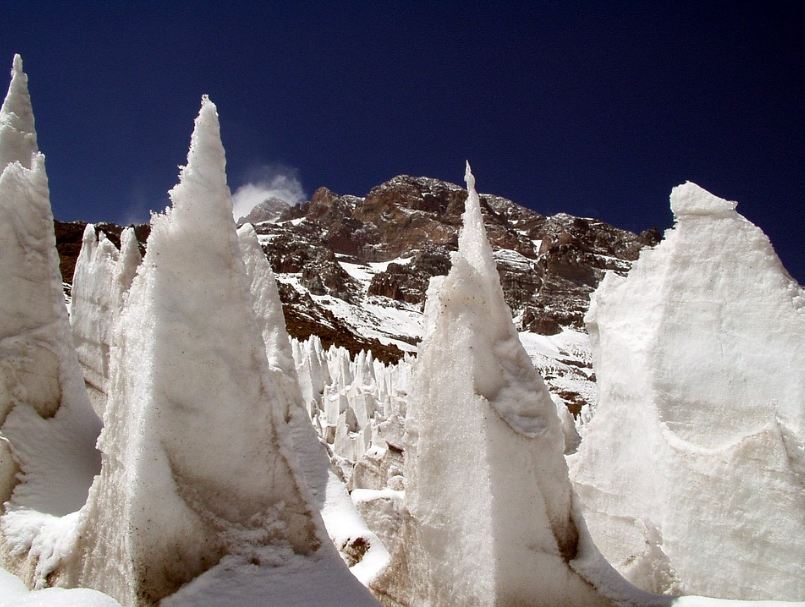Nature’s natural processes often create some of the most beautiful and seamless things ever seen by the naked eye. Included in these are the remarkable ones known as the Penitentes, located on the high altitude glaciers of the dry Andes bordering Chile and Argentina.
Penitentes, also known as nieves penitentes, a Spanish term meaning “penitent-shaped snows,” are uncommon snow forms usually found in high-altitude places with lesser moisture. They resemble tall and thin blades of solidified snow or ice tightly scattered and pointed in the sun’s direction.
Penitentes often grow in groups and generally range from a few centimeters to two meters, while penitentes as tall as five meters also exist. You can mostly see these tall blades in the snowy areas 4,000 meters beyond the Dry Andes.
The term originates from the similarities of a field of penitentes to a crowd of kneeling parishioners carrying out penance. The formation takes after the tall and pointed hats worn by Monks and other religious brothers during the Penitential Processions in Spain every Holy Week. The brothers’ hats are tall, slim, and white, with a pointed peak.
Penitentes have existed for a long time now. Actually, Charles Darwin published literature about them. On his trip from Santiago de Chile to Mendoza, Argentina, on March 22, 1835, he once squeezed through snowy mountains filled with penitentes along the Piuquenes Pass. He recounted the common belief that powerful Andes winds formed these penitentes.
But, do Andes winds really form the spiky snowy formation?
HOW ARE PENITENTES FORMED?
Snow penitentes are not a simple process relying on a single erosive element. It is actually a phenomenon caused by numerous physical processes. If you also want to know the coldest places in the world, click the given link.
In actuality, Penitentes do not form because of the strong winds. They form when the sun’s rays convert snow to water vapor without melting it. This conversion is known as sublimation.
The sun induces melting, sublimation, or both on a snowy surface, starting at areas of lesser density. It is not possible to have an entirely homogenous snowfield. Dust, for instance, can speed up the formation of pits and hollows and increase their form and quantity.
The intricate process begins once the emerging hollows are established. The original structure of the topmost snow cover has a big impact on the formation and number of the pits and the snow penitentes formed afterward.
You may compare the process to crystallization from a melt or a solution in that the kind and quantity of nuclei and the speed with which they develop determine the final product. The final shape and formation of the penitentes are influenced by prior conditions and the real nature of the process.
Since certain places unexpectedly sublimate faster than most others, the initially flat snow-covered surface accumulates depressions. The curving areas concentrate sunlight and quicken sublimation in the recesses, creating the higher elevations as towering spike forests.
These tall spikes, on the microscale, aid the snowy surface in maximizing sunlight absorption. And it’s so arid where penitentes grow that heat evaporates snow instantly into steam. After a while, the process hollows down the gaps between the spikes.
Based on some theories, the distance between the tall snow formations in any particular location is fairly standardized since it is affected by wind speed. More water vapor is blown away by the wind, allowing more snow to be evaporated in its place and generating more bottomless pits between spikes.
Scientists recently claimed that the presence of carbon or other impurities causes significant sunlight absorption and, as a result, the formation of Penitentes. If this claim is correct, the glaciers may be spared from the impacts of global warming.
However, there are refutes to this notion. Some counter-arguments include the possibility that if the Penitentes absorb greater sunlight due to the presence of carbon, it will destroy the icebergs. Because of this topic, scientists conduct researches to determine the impacts of global warming on the development of Penitentes.
SNOW PENITENTES IN OTHER PLACES
Scientists discovered that this unusual erosional structure is not limited to the tropics but may be found on every continent and at all latitudes. Only the most prominent examples are seen in the tropical regions and at high altitudes because of the greater quantity of the processes and agents involved and the occurrence of these processes several times.
And penitentes may not be only exclusive to Earth. These snow formations have been discovered on Pluto, although they are made of nitrogen and methane instead of water. Scientists also believe these penitentes could exist on Europa, Jupiter’s ice moon, one of the most likely prospects for extraterrestrial life.
LIFE ON THE SNOW PENITENTES
Reddish pink smudges were detected on approximately meter tall penitentes by a team of scientists. Only around 0.1 percent of the penitentes in the area had any coloring. Aside from that, the reddish smudges appeared to be biological.
Scientists started comparing the DNA sequences of the specimens with those from well-known organisms. Then they discovered a great match with samples of the snow algae called Chlamydomonas nivalis collected from Antarctica, Mount Kilimanjaro, and the Swiss Alps.
However, not all of the specimens from penitentes’ DNA correspond with Chlamydomonas nivalis. Others likely came from other snow algae species related to another genus, Chloromonas, and possibly other unidentified species.
Scientists believe that this was the first-ever discovery of microorganisms found in the penitentes. According to the scientists who discovered these microbes, it has astrobiological indications that ice could give a foundation for life outside the Earth. If you find this post interesting, we recommend you also read our post about the animal species that live in the coldest parts of the Earth.



